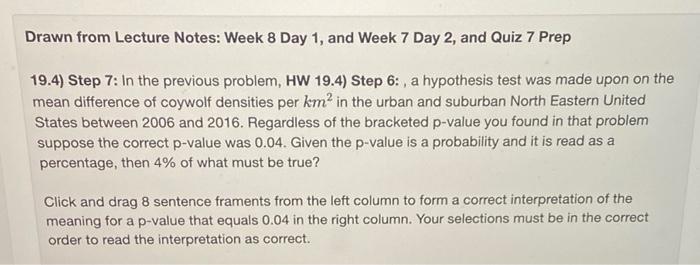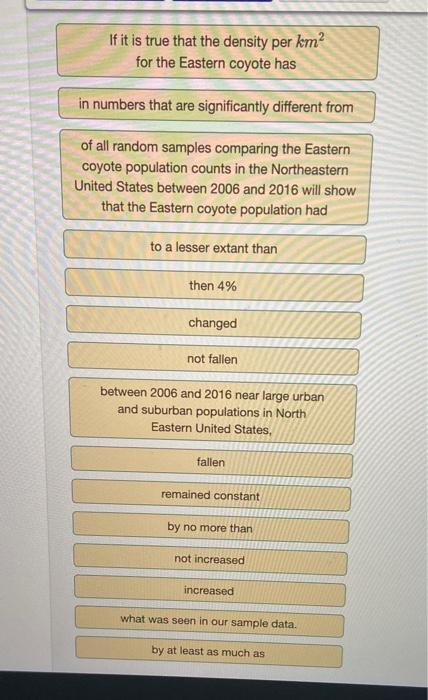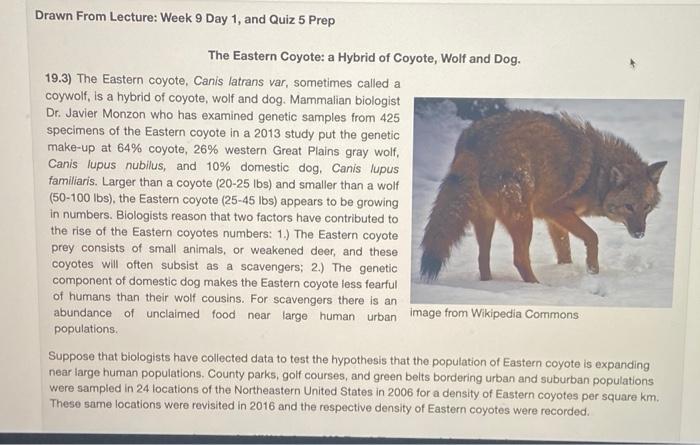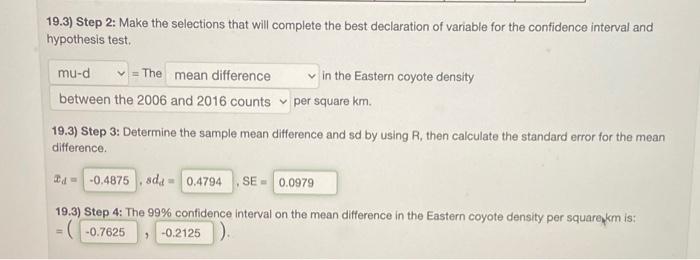Answered step by step
Verified Expert Solution
Question
1 Approved Answer
need 8 sentences in the correct order Drawn from Lecture Notes: Week 8 Day 1, and Week 7 Day 2, and Quiz 7 Prep 19.4)
need 8 sentences in the correct order 




Drawn from Lecture Notes: Week 8 Day 1, and Week 7 Day 2, and Quiz 7 Prep 19.4) Step 7: In the previous problem, HW 19.4) Step 6: , a hypothesis test was made upon on the mean difference of coywolf densities per km in the urban and suburban North Eastern United States between 2006 and 2016. Regardless of the bracketed p-value you found in that problem suppose the correct p-value was 0.04. Given the p-value is a probability and it is read as a percentage, then 4% of what must be true? Click and drag 8 sentence framents from the left column to form a correct interpretation of the meaning for a p-value that equals 0.04 in the right column. Your selections must be in the correct order to read the interpretation as correct. If it is true that the density per km2 for the Eastern coyote has in numbers that are significantly different from of all random samples comparing the Eastern coyote population counts in the Northeastern United States between 2006 and 2016 will show that the Eastern coyote population had to a lesser extant than then 4% changed not fallen between 2006 and 2016 near large urban and suburban populations in North Eastern United States, fallen remained constant by no more than not increased increased what was seen in our sample data. by at least as much as Drawn From Lecture: Week 9 Day 1, and Quiz 5 Prep The Eastern Coyote: a Hybrid of Coyote, Wolf and Dog. 19.3) The Eastern coyote, Canis latrans var, sometimes called a coywolf, is a hybrid of coyote, wolf and dog. Mammalian biologist Dr. Javier Monzon who has examined genetic samples from 425 specimens of the Eastern coyote in a 2013 study put the genetic make-up at 64% coyote, 26% western Great Plains gray wolf, Canis lupus nubilus, and 10% domestic dog, Canis lupus familiaris. Larger than a coyote (20-25 lbs) and smaller than a wolf (50-100 lbs), the Eastern coyote (25-45 lbs) appears to be growing in numbers. Biologists reason that two factors have contributed to the rise of the Eastern coyotes numbers: 1.) The Eastern coyote prey consists of small animals, or weakened deer, and these coyotes will often subsist as a scavengers; 2.) The genetic component of domestic dog makes the Eastern coyote less fearful of humans than their wolf cousins. For scavengers there is an abundance of unclaimed food near large human urban image from Wikipedia Commons populations Suppose that biologists have collected data to test the hypothesis that the population of Eastern coyote is expanding near large human populations. County parks, golf courses, and green belts bordering urban and suburban populations were sampled in 24 locations of the Northeastern United States in 2006 for a density of Eastern coyotes per square km. These same locations were revisited in 2016 and the respective density of Eastern coyotes were recorded. Note: Problem 19.3 Is a hand calculation problem. You may use to calculate for , sd, and normality but the palculation of the Cl and hypothesis test statistic is to be done using the appropriate formulas, not R. va 19.3) Step 1: Preliminary checks: Test the data for normality. P> The data set is consistent with a normal 0.01 distribution because by the Anderson-Darling Normality test: The results of the normality test tell us that the mean should be used to represent the average value for the data. > 19.3) Step 2: Make the selections that will complete the best declaration of variable for the confidence interval and hypothesis test mu-d = The mean difference in the Eastern coyote density between the 2006 and 2016 counts per square km. 19.3) Step 3: Determine the sample mean difference and sd by using R, then calculate the standard error for the mean difference. 01 -0.4875 , sdd - 0,4794 SE- 0.0979 19.3) Step 4: The 99% confidence interval on the mean difference in the Eastern coyote density per squaroyom is: -( -0.7625 9 -0.2125 Drawn from Lecture Notes: Week 8 Day 1, and Week 7 Day 2, and Quiz 7 Prep 19.4) Step 7: In the previous problem, HW 19.4) Step 6: , a hypothesis test was made upon on the mean difference of coywolf densities per km in the urban and suburban North Eastern United States between 2006 and 2016. Regardless of the bracketed p-value you found in that problem suppose the correct p-value was 0.04. Given the p-value is a probability and it is read as a percentage, then 4% of what must be true? Click and drag 8 sentence framents from the left column to form a correct interpretation of the meaning for a p-value that equals 0.04 in the right column. Your selections must be in the correct order to read the interpretation as correct. If it is true that the density per km2 for the Eastern coyote has in numbers that are significantly different from of all random samples comparing the Eastern coyote population counts in the Northeastern United States between 2006 and 2016 will show that the Eastern coyote population had to a lesser extant than then 4% changed not fallen between 2006 and 2016 near large urban and suburban populations in North Eastern United States, fallen remained constant by no more than not increased increased what was seen in our sample data. by at least as much as Drawn From Lecture: Week 9 Day 1, and Quiz 5 Prep The Eastern Coyote: a Hybrid of Coyote, Wolf and Dog. 19.3) The Eastern coyote, Canis latrans var, sometimes called a coywolf, is a hybrid of coyote, wolf and dog. Mammalian biologist Dr. Javier Monzon who has examined genetic samples from 425 specimens of the Eastern coyote in a 2013 study put the genetic make-up at 64% coyote, 26% western Great Plains gray wolf, Canis lupus nubilus, and 10% domestic dog, Canis lupus familiaris. Larger than a coyote (20-25 lbs) and smaller than a wolf (50-100 lbs), the Eastern coyote (25-45 lbs) appears to be growing in numbers. Biologists reason that two factors have contributed to the rise of the Eastern coyotes numbers: 1.) The Eastern coyote prey consists of small animals, or weakened deer, and these coyotes will often subsist as a scavengers; 2.) The genetic component of domestic dog makes the Eastern coyote less fearful of humans than their wolf cousins. For scavengers there is an abundance of unclaimed food near large human urban image from Wikipedia Commons populations Suppose that biologists have collected data to test the hypothesis that the population of Eastern coyote is expanding near large human populations. County parks, golf courses, and green belts bordering urban and suburban populations were sampled in 24 locations of the Northeastern United States in 2006 for a density of Eastern coyotes per square km. These same locations were revisited in 2016 and the respective density of Eastern coyotes were recorded. Note: Problem 19.3 Is a hand calculation problem. You may use to calculate for , sd, and normality but the palculation of the Cl and hypothesis test statistic is to be done using the appropriate formulas, not R. va 19.3) Step 1: Preliminary checks: Test the data for normality. P> The data set is consistent with a normal 0.01 distribution because by the Anderson-Darling Normality test: The results of the normality test tell us that the mean should be used to represent the average value for the data. > 19.3) Step 2: Make the selections that will complete the best declaration of variable for the confidence interval and hypothesis test mu-d = The mean difference in the Eastern coyote density between the 2006 and 2016 counts per square km. 19.3) Step 3: Determine the sample mean difference and sd by using R, then calculate the standard error for the mean difference. 01 -0.4875 , sdd - 0,4794 SE- 0.0979 19.3) Step 4: The 99% confidence interval on the mean difference in the Eastern coyote density per squaroyom is: -( -0.7625 9 -0.2125 




Step by Step Solution
There are 3 Steps involved in it
Step: 1

Get Instant Access to Expert-Tailored Solutions
See step-by-step solutions with expert insights and AI powered tools for academic success
Step: 2

Step: 3

Ace Your Homework with AI
Get the answers you need in no time with our AI-driven, step-by-step assistance
Get Started


